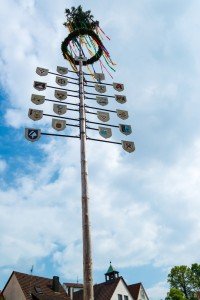Germany marks the beginning of spring during the month of May. The cold and gray winter days are sent on their way with a cheerful “Ade,” or farewell. Traditionally, May is welcomed with fests, music and dance to celebrate the long-awaited arrival of spring. Whether out in the country, downtown Stuttgart, or in the surrounding towns, May is celebrated in many different ways throughout Baden-Württemberg.
May celebrations in Germany are called “Tanz in den Mai” (Dance into May). These include a variety of events such as setting up the “Maibaum” (May tree or May pole), as well as a number of cozy little outdoor fests, known as “Maihocketse.” Hocketse, in the Swabian dialect, means sitting down.
The little towns in the greater Stuttgart area host their “Maihocketse” starting on April 30 until the end of May, mainly on weekends. At these celebrations, you can enjoy traditional Volksmusik, hearty Swabian food, freshly brewed beer and local wine.

You may have already passed a “Maibaum” while driving through the surrounding towns and villages of Stuttgart. In general, the Maibaum is set up in the center of a town — the market place — during the morning hours on May 1. It remains there throughout the month of May. The Maibaum is an oak tree trunk with a green crown that symbolizes fertility of nature and new life.
The tradition of setting up a Maibaum dates back to the 13th century and was customary as a religious practice in Austria, Bavaria and Baden-Württemberg to represent new life, the beginning of spring and the earth awakening from winter’s sleep. The tree trunk of the Maibaum is decorated with a garland made of spruce branches, one or two wreaths, as well as blue and white bands (seen mainly in Bavaria).
The hand-crafted wooden figures, guild symbols and painted pictures that decorate the trunk reflect upon and tell the story of the village or town in which it is located. Another tradition in May is Vatertag, or Father’s Day, dedicated to all the fathers of the world.
The origins of Germany’s Vatertag date back to the Middle Ages when people attended a religious procession honoring “Gott den Vater” (God the Father) on Ascension Day (Christi Himmelfahrt), which is always on the Thursday 40 days after Easter. This year, Vatertag falls on June 2, although it is sometimes in May. Until the late 1700s, Vatertag was considered a family day to honor dad. During the 19th century, this tradition changed. Today, Germany’s Vatertag is celebrated in the fashion of a “boy’s day out” or a tour with the guys (Maennerrunde).
In the Baden-Württemberg region, “Vatertagswanderungen” (Father’s Day tours) are a well-known tradition. Fathers meet up with male friends and family members with a little toy wagon, or “Leiterwaegele,” in tow, to transport the most important ingredient for a successful father’s day trip: a keg filled with fresh German beer. The group walks the vineyards around Stuttgart and Esslingen, stopping here and there barbecue, beer, wine and a good time.
